Case Study on Respiratory System: Asthma Treatment Options
VerifiedAdded on 2021/04/17
|7
|1888
|266
Case Study
AI Summary
This case study examines asthma through a detailed analysis of a patient's symptoms and medical history. It explores the different types of asthma, including allergic asthma and AERD, considering both genetic and environmental factors. The study delves into the pathophysiology of asthma, highlighting airflow obstruction and chronic airway inflammation. It then reviews various treatment options available in Australia, such as inhaled corticosteroids (ICS), oral corticosteroids (OCS), and anti-IgE monoclonal antibody therapy. The case study also emphasizes the importance of primary care in managing asthma, including patient education on triggers, symptoms, and medication use. The patient and their families should receive adequate education about the disease and first aid before discharge from the hospital.
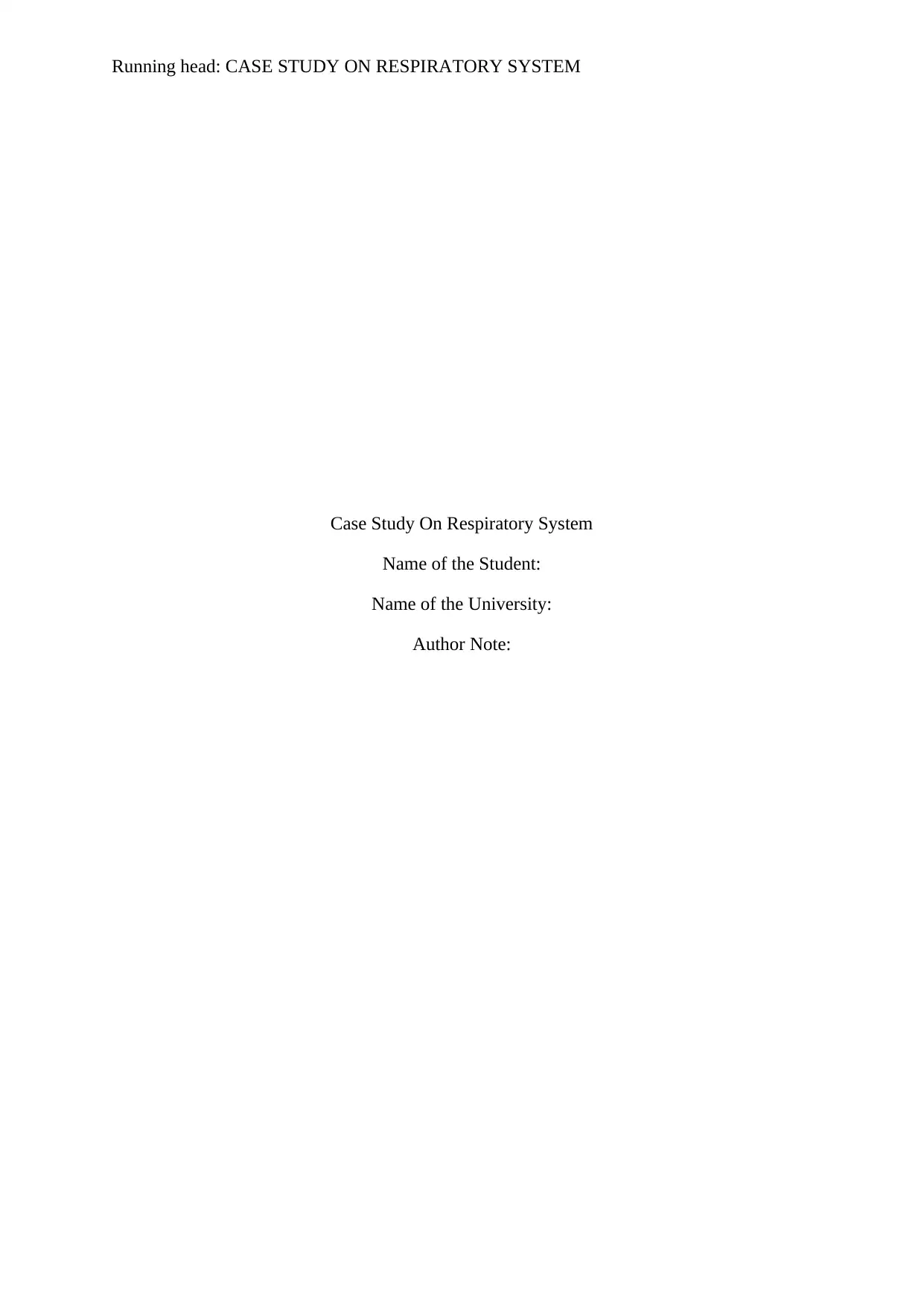
Running head: CASE STUDY ON RESPIRATORY SYSTEM
Case Study On Respiratory System
Name of the Student:
Name of the University:
Author Note:
Case Study On Respiratory System
Name of the Student:
Name of the University:
Author Note:
Paraphrase This Document
Need a fresh take? Get an instant paraphrase of this document with our AI Paraphraser
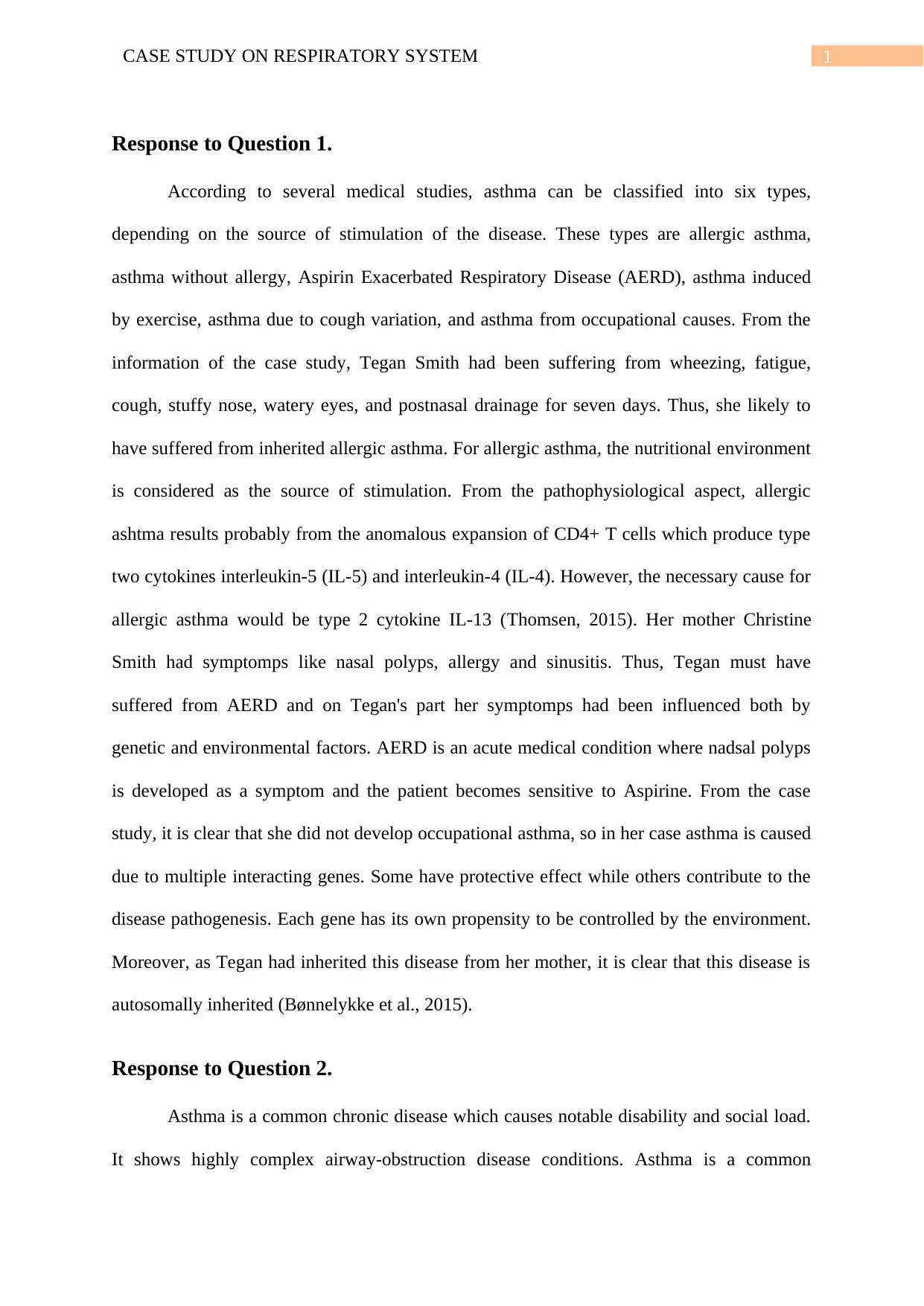
1CASE STUDY ON RESPIRATORY SYSTEM
Response to Question 1.
According to several medical studies, asthma can be classified into six types,
depending on the source of stimulation of the disease. These types are allergic asthma,
asthma without allergy, Aspirin Exacerbated Respiratory Disease (AERD), asthma induced
by exercise, asthma due to cough variation, and asthma from occupational causes. From the
information of the case study, Tegan Smith had been suffering from wheezing, fatigue,
cough, stuffy nose, watery eyes, and postnasal drainage for seven days. Thus, she likely to
have suffered from inherited allergic asthma. For allergic asthma, the nutritional environment
is considered as the source of stimulation. From the pathophysiological aspect, allergic
ashtma results probably from the anomalous expansion of CD4+ T cells which produce type
two cytokines interleukin-5 (IL-5) and interleukin-4 (IL-4). However, the necessary cause for
allergic asthma would be type 2 cytokine IL-13 (Thomsen, 2015). Her mother Christine
Smith had symptomps like nasal polyps, allergy and sinusitis. Thus, Tegan must have
suffered from AERD and on Tegan's part her symptomps had been influenced both by
genetic and environmental factors. AERD is an acute medical condition where nadsal polyps
is developed as a symptom and the patient becomes sensitive to Aspirine. From the case
study, it is clear that she did not develop occupational asthma, so in her case asthma is caused
due to multiple interacting genes. Some have protective effect while others contribute to the
disease pathogenesis. Each gene has its own propensity to be controlled by the environment.
Moreover, as Tegan had inherited this disease from her mother, it is clear that this disease is
autosomally inherited (Bønnelykke et al., 2015).
Response to Question 2.
Asthma is a common chronic disease which causes notable disability and social load.
It shows highly complex airway-obstruction disease conditions. Asthma is a common
Response to Question 1.
According to several medical studies, asthma can be classified into six types,
depending on the source of stimulation of the disease. These types are allergic asthma,
asthma without allergy, Aspirin Exacerbated Respiratory Disease (AERD), asthma induced
by exercise, asthma due to cough variation, and asthma from occupational causes. From the
information of the case study, Tegan Smith had been suffering from wheezing, fatigue,
cough, stuffy nose, watery eyes, and postnasal drainage for seven days. Thus, she likely to
have suffered from inherited allergic asthma. For allergic asthma, the nutritional environment
is considered as the source of stimulation. From the pathophysiological aspect, allergic
ashtma results probably from the anomalous expansion of CD4+ T cells which produce type
two cytokines interleukin-5 (IL-5) and interleukin-4 (IL-4). However, the necessary cause for
allergic asthma would be type 2 cytokine IL-13 (Thomsen, 2015). Her mother Christine
Smith had symptomps like nasal polyps, allergy and sinusitis. Thus, Tegan must have
suffered from AERD and on Tegan's part her symptomps had been influenced both by
genetic and environmental factors. AERD is an acute medical condition where nadsal polyps
is developed as a symptom and the patient becomes sensitive to Aspirine. From the case
study, it is clear that she did not develop occupational asthma, so in her case asthma is caused
due to multiple interacting genes. Some have protective effect while others contribute to the
disease pathogenesis. Each gene has its own propensity to be controlled by the environment.
Moreover, as Tegan had inherited this disease from her mother, it is clear that this disease is
autosomally inherited (Bønnelykke et al., 2015).
Response to Question 2.
Asthma is a common chronic disease which causes notable disability and social load.
It shows highly complex airway-obstruction disease conditions. Asthma is a common
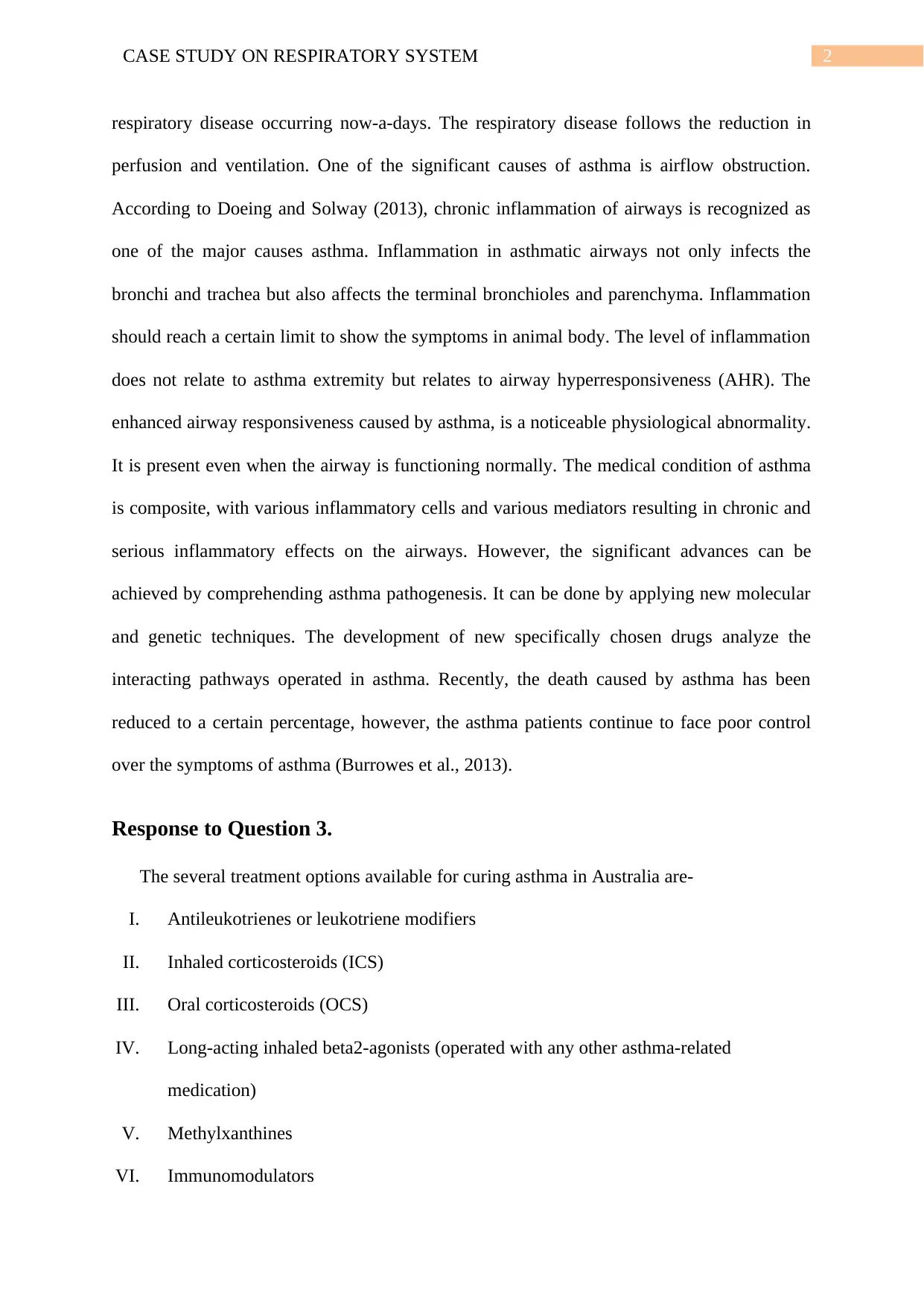
2CASE STUDY ON RESPIRATORY SYSTEM
respiratory disease occurring now-a-days. The respiratory disease follows the reduction in
perfusion and ventilation. One of the significant causes of asthma is airflow obstruction.
According to Doeing and Solway (2013), chronic inflammation of airways is recognized as
one of the major causes asthma. Inflammation in asthmatic airways not only infects the
bronchi and trachea but also affects the terminal bronchioles and parenchyma. Inflammation
should reach a certain limit to show the symptoms in animal body. The level of inflammation
does not relate to asthma extremity but relates to airway hyperresponsiveness (AHR). The
enhanced airway responsiveness caused by asthma, is a noticeable physiological abnormality.
It is present even when the airway is functioning normally. The medical condition of asthma
is composite, with various inflammatory cells and various mediators resulting in chronic and
serious inflammatory effects on the airways. However, the significant advances can be
achieved by comprehending asthma pathogenesis. It can be done by applying new molecular
and genetic techniques. The development of new specifically chosen drugs analyze the
interacting pathways operated in asthma. Recently, the death caused by asthma has been
reduced to a certain percentage, however, the asthma patients continue to face poor control
over the symptoms of asthma (Burrowes et al., 2013).
Response to Question 3.
The several treatment options available for curing asthma in Australia are-
I. Antileukotrienes or leukotriene modifiers
II. Inhaled corticosteroids (ICS)
III. Oral corticosteroids (OCS)
IV. Long-acting inhaled beta2-agonists (operated with any other asthma-related
medication)
V. Methylxanthines
VI. Immunomodulators
respiratory disease occurring now-a-days. The respiratory disease follows the reduction in
perfusion and ventilation. One of the significant causes of asthma is airflow obstruction.
According to Doeing and Solway (2013), chronic inflammation of airways is recognized as
one of the major causes asthma. Inflammation in asthmatic airways not only infects the
bronchi and trachea but also affects the terminal bronchioles and parenchyma. Inflammation
should reach a certain limit to show the symptoms in animal body. The level of inflammation
does not relate to asthma extremity but relates to airway hyperresponsiveness (AHR). The
enhanced airway responsiveness caused by asthma, is a noticeable physiological abnormality.
It is present even when the airway is functioning normally. The medical condition of asthma
is composite, with various inflammatory cells and various mediators resulting in chronic and
serious inflammatory effects on the airways. However, the significant advances can be
achieved by comprehending asthma pathogenesis. It can be done by applying new molecular
and genetic techniques. The development of new specifically chosen drugs analyze the
interacting pathways operated in asthma. Recently, the death caused by asthma has been
reduced to a certain percentage, however, the asthma patients continue to face poor control
over the symptoms of asthma (Burrowes et al., 2013).
Response to Question 3.
The several treatment options available for curing asthma in Australia are-
I. Antileukotrienes or leukotriene modifiers
II. Inhaled corticosteroids (ICS)
III. Oral corticosteroids (OCS)
IV. Long-acting inhaled beta2-agonists (operated with any other asthma-related
medication)
V. Methylxanthines
VI. Immunomodulators
⊘ This is a preview!⊘
Do you want full access?
Subscribe today to unlock all pages.

Trusted by 1+ million students worldwide
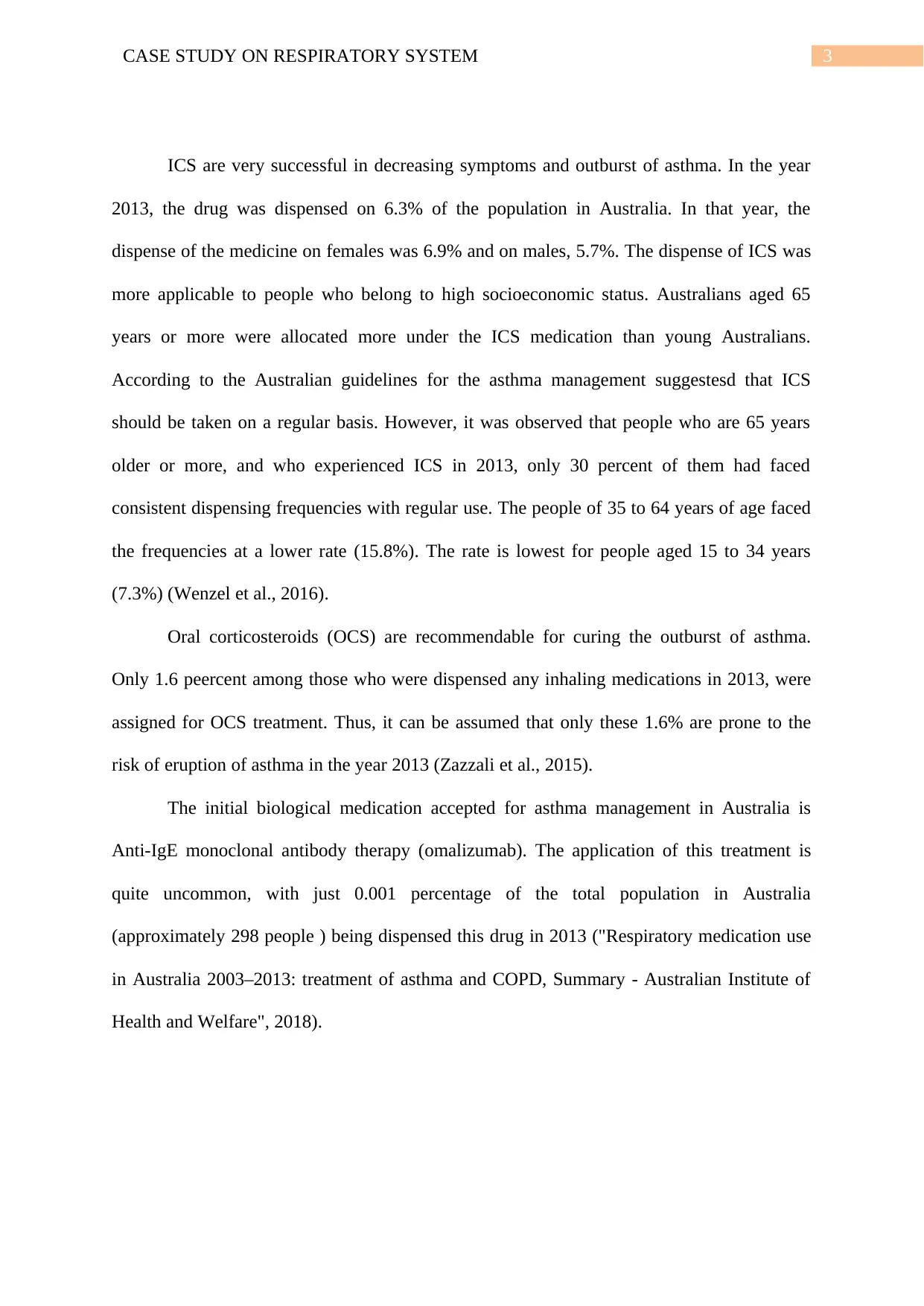
3CASE STUDY ON RESPIRATORY SYSTEM
ICS are very successful in decreasing symptoms and outburst of asthma. In the year
2013, the drug was dispensed on 6.3% of the population in Australia. In that year, the
dispense of the medicine on females was 6.9% and on males, 5.7%. The dispense of ICS was
more applicable to people who belong to high socioeconomic status. Australians aged 65
years or more were allocated more under the ICS medication than young Australians.
According to the Australian guidelines for the asthma management suggestesd that ICS
should be taken on a regular basis. However, it was observed that people who are 65 years
older or more, and who experienced ICS in 2013, only 30 percent of them had faced
consistent dispensing frequencies with regular use. The people of 35 to 64 years of age faced
the frequencies at a lower rate (15.8%). The rate is lowest for people aged 15 to 34 years
(7.3%) (Wenzel et al., 2016).
Oral corticosteroids (OCS) are recommendable for curing the outburst of asthma.
Only 1.6 peercent among those who were dispensed any inhaling medications in 2013, were
assigned for OCS treatment. Thus, it can be assumed that only these 1.6% are prone to the
risk of eruption of asthma in the year 2013 (Zazzali et al., 2015).
The initial biological medication accepted for asthma management in Australia is
Anti-IgE monoclonal antibody therapy (omalizumab). The application of this treatment is
quite uncommon, with just 0.001 percentage of the total population in Australia
(approximately 298 people ) being dispensed this drug in 2013 ("Respiratory medication use
in Australia 2003–2013: treatment of asthma and COPD, Summary - Australian Institute of
Health and Welfare", 2018).
ICS are very successful in decreasing symptoms and outburst of asthma. In the year
2013, the drug was dispensed on 6.3% of the population in Australia. In that year, the
dispense of the medicine on females was 6.9% and on males, 5.7%. The dispense of ICS was
more applicable to people who belong to high socioeconomic status. Australians aged 65
years or more were allocated more under the ICS medication than young Australians.
According to the Australian guidelines for the asthma management suggestesd that ICS
should be taken on a regular basis. However, it was observed that people who are 65 years
older or more, and who experienced ICS in 2013, only 30 percent of them had faced
consistent dispensing frequencies with regular use. The people of 35 to 64 years of age faced
the frequencies at a lower rate (15.8%). The rate is lowest for people aged 15 to 34 years
(7.3%) (Wenzel et al., 2016).
Oral corticosteroids (OCS) are recommendable for curing the outburst of asthma.
Only 1.6 peercent among those who were dispensed any inhaling medications in 2013, were
assigned for OCS treatment. Thus, it can be assumed that only these 1.6% are prone to the
risk of eruption of asthma in the year 2013 (Zazzali et al., 2015).
The initial biological medication accepted for asthma management in Australia is
Anti-IgE monoclonal antibody therapy (omalizumab). The application of this treatment is
quite uncommon, with just 0.001 percentage of the total population in Australia
(approximately 298 people ) being dispensed this drug in 2013 ("Respiratory medication use
in Australia 2003–2013: treatment of asthma and COPD, Summary - Australian Institute of
Health and Welfare", 2018).
Paraphrase This Document
Need a fresh take? Get an instant paraphrase of this document with our AI Paraphraser
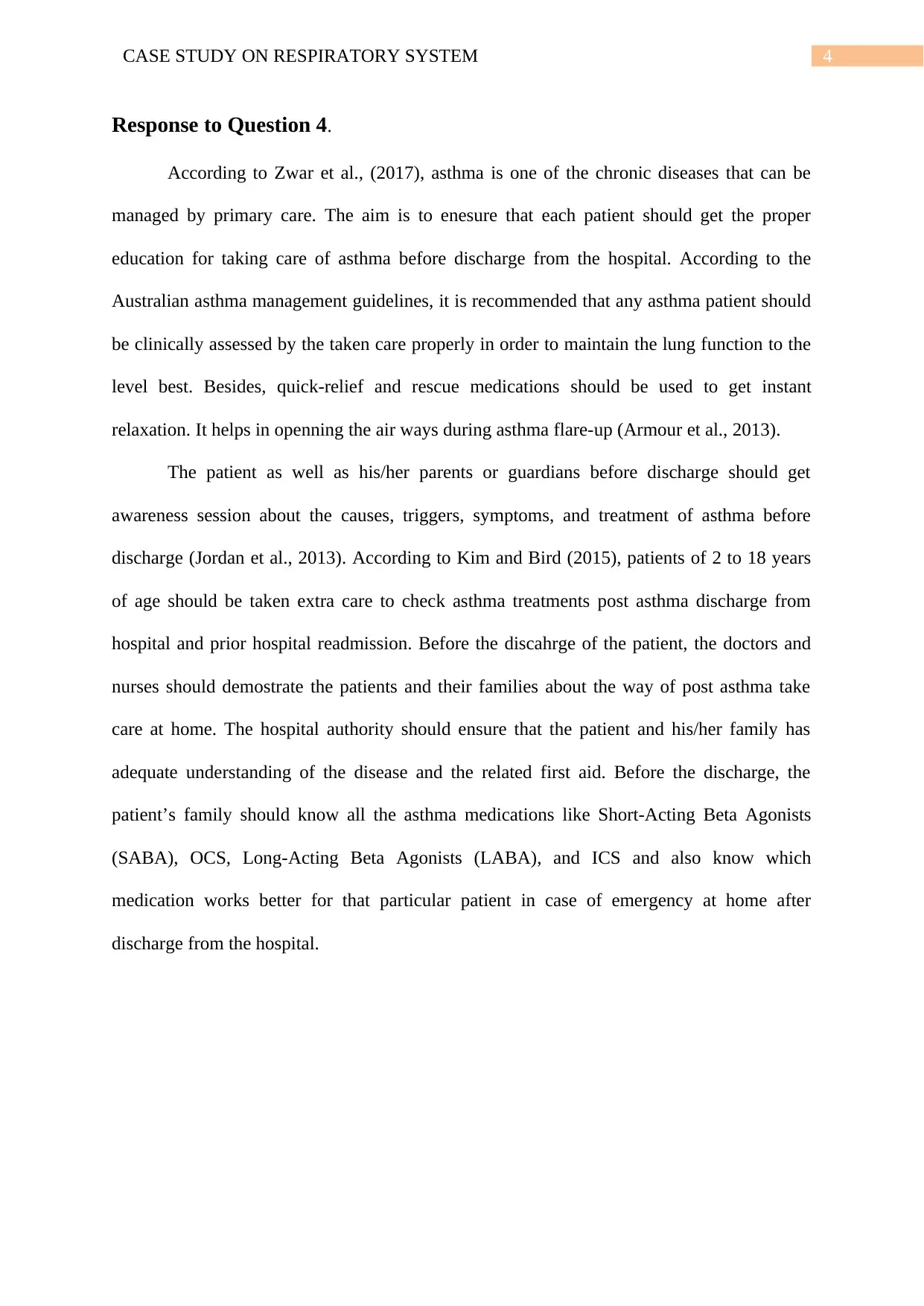
4CASE STUDY ON RESPIRATORY SYSTEM
Response to Question 4.
According to Zwar et al., (2017), asthma is one of the chronic diseases that can be
managed by primary care. The aim is to enesure that each patient should get the proper
education for taking care of asthma before discharge from the hospital. According to the
Australian asthma management guidelines, it is recommended that any asthma patient should
be clinically assessed by the taken care properly in order to maintain the lung function to the
level best. Besides, quick-relief and rescue medications should be used to get instant
relaxation. It helps in openning the air ways during asthma flare-up (Armour et al., 2013).
The patient as well as his/her parents or guardians before discharge should get
awareness session about the causes, triggers, symptoms, and treatment of asthma before
discharge (Jordan et al., 2013). According to Kim and Bird (2015), patients of 2 to 18 years
of age should be taken extra care to check asthma treatments post asthma discharge from
hospital and prior hospital readmission. Before the discahrge of the patient, the doctors and
nurses should demostrate the patients and their families about the way of post asthma take
care at home. The hospital authority should ensure that the patient and his/her family has
adequate understanding of the disease and the related first aid. Before the discharge, the
patient’s family should know all the asthma medications like Short-Acting Beta Agonists
(SABA), OCS, Long-Acting Beta Agonists (LABA), and ICS and also know which
medication works better for that particular patient in case of emergency at home after
discharge from the hospital.
Response to Question 4.
According to Zwar et al., (2017), asthma is one of the chronic diseases that can be
managed by primary care. The aim is to enesure that each patient should get the proper
education for taking care of asthma before discharge from the hospital. According to the
Australian asthma management guidelines, it is recommended that any asthma patient should
be clinically assessed by the taken care properly in order to maintain the lung function to the
level best. Besides, quick-relief and rescue medications should be used to get instant
relaxation. It helps in openning the air ways during asthma flare-up (Armour et al., 2013).
The patient as well as his/her parents or guardians before discharge should get
awareness session about the causes, triggers, symptoms, and treatment of asthma before
discharge (Jordan et al., 2013). According to Kim and Bird (2015), patients of 2 to 18 years
of age should be taken extra care to check asthma treatments post asthma discharge from
hospital and prior hospital readmission. Before the discahrge of the patient, the doctors and
nurses should demostrate the patients and their families about the way of post asthma take
care at home. The hospital authority should ensure that the patient and his/her family has
adequate understanding of the disease and the related first aid. Before the discharge, the
patient’s family should know all the asthma medications like Short-Acting Beta Agonists
(SABA), OCS, Long-Acting Beta Agonists (LABA), and ICS and also know which
medication works better for that particular patient in case of emergency at home after
discharge from the hospital.
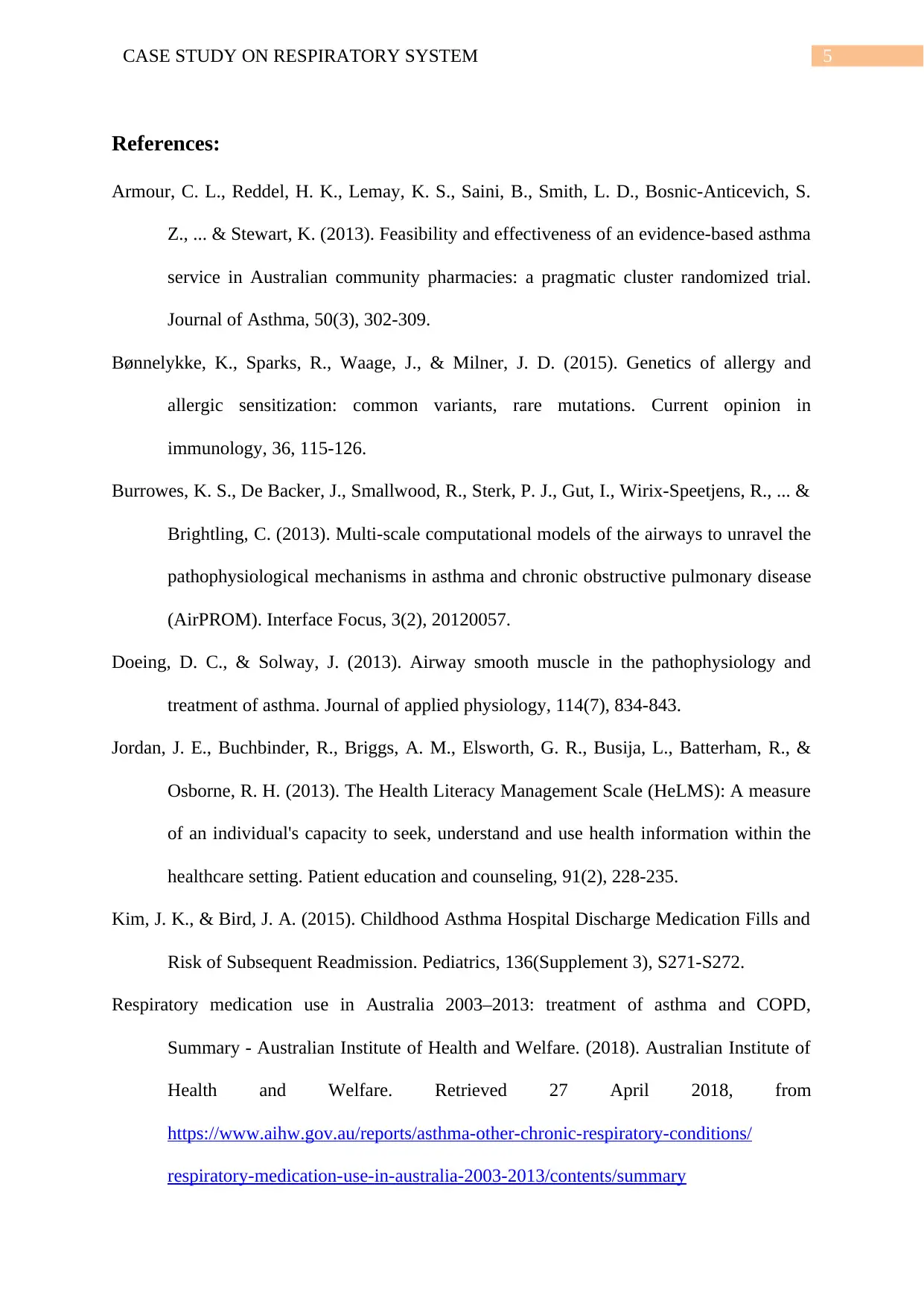
5CASE STUDY ON RESPIRATORY SYSTEM
References:
Armour, C. L., Reddel, H. K., Lemay, K. S., Saini, B., Smith, L. D., Bosnic-Anticevich, S.
Z., ... & Stewart, K. (2013). Feasibility and effectiveness of an evidence-based asthma
service in Australian community pharmacies: a pragmatic cluster randomized trial.
Journal of Asthma, 50(3), 302-309.
Bønnelykke, K., Sparks, R., Waage, J., & Milner, J. D. (2015). Genetics of allergy and
allergic sensitization: common variants, rare mutations. Current opinion in
immunology, 36, 115-126.
Burrowes, K. S., De Backer, J., Smallwood, R., Sterk, P. J., Gut, I., Wirix-Speetjens, R., ... &
Brightling, C. (2013). Multi-scale computational models of the airways to unravel the
pathophysiological mechanisms in asthma and chronic obstructive pulmonary disease
(AirPROM). Interface Focus, 3(2), 20120057.
Doeing, D. C., & Solway, J. (2013). Airway smooth muscle in the pathophysiology and
treatment of asthma. Journal of applied physiology, 114(7), 834-843.
Jordan, J. E., Buchbinder, R., Briggs, A. M., Elsworth, G. R., Busija, L., Batterham, R., &
Osborne, R. H. (2013). The Health Literacy Management Scale (HeLMS): A measure
of an individual's capacity to seek, understand and use health information within the
healthcare setting. Patient education and counseling, 91(2), 228-235.
Kim, J. K., & Bird, J. A. (2015). Childhood Asthma Hospital Discharge Medication Fills and
Risk of Subsequent Readmission. Pediatrics, 136(Supplement 3), S271-S272.
Respiratory medication use in Australia 2003–2013: treatment of asthma and COPD,
Summary - Australian Institute of Health and Welfare. (2018). Australian Institute of
Health and Welfare. Retrieved 27 April 2018, from
https://www.aihw.gov.au/reports/asthma-other-chronic-respiratory-conditions/
respiratory-medication-use-in-australia-2003-2013/contents/summary
References:
Armour, C. L., Reddel, H. K., Lemay, K. S., Saini, B., Smith, L. D., Bosnic-Anticevich, S.
Z., ... & Stewart, K. (2013). Feasibility and effectiveness of an evidence-based asthma
service in Australian community pharmacies: a pragmatic cluster randomized trial.
Journal of Asthma, 50(3), 302-309.
Bønnelykke, K., Sparks, R., Waage, J., & Milner, J. D. (2015). Genetics of allergy and
allergic sensitization: common variants, rare mutations. Current opinion in
immunology, 36, 115-126.
Burrowes, K. S., De Backer, J., Smallwood, R., Sterk, P. J., Gut, I., Wirix-Speetjens, R., ... &
Brightling, C. (2013). Multi-scale computational models of the airways to unravel the
pathophysiological mechanisms in asthma and chronic obstructive pulmonary disease
(AirPROM). Interface Focus, 3(2), 20120057.
Doeing, D. C., & Solway, J. (2013). Airway smooth muscle in the pathophysiology and
treatment of asthma. Journal of applied physiology, 114(7), 834-843.
Jordan, J. E., Buchbinder, R., Briggs, A. M., Elsworth, G. R., Busija, L., Batterham, R., &
Osborne, R. H. (2013). The Health Literacy Management Scale (HeLMS): A measure
of an individual's capacity to seek, understand and use health information within the
healthcare setting. Patient education and counseling, 91(2), 228-235.
Kim, J. K., & Bird, J. A. (2015). Childhood Asthma Hospital Discharge Medication Fills and
Risk of Subsequent Readmission. Pediatrics, 136(Supplement 3), S271-S272.
Respiratory medication use in Australia 2003–2013: treatment of asthma and COPD,
Summary - Australian Institute of Health and Welfare. (2018). Australian Institute of
Health and Welfare. Retrieved 27 April 2018, from
https://www.aihw.gov.au/reports/asthma-other-chronic-respiratory-conditions/
respiratory-medication-use-in-australia-2003-2013/contents/summary
⊘ This is a preview!⊘
Do you want full access?
Subscribe today to unlock all pages.

Trusted by 1+ million students worldwide
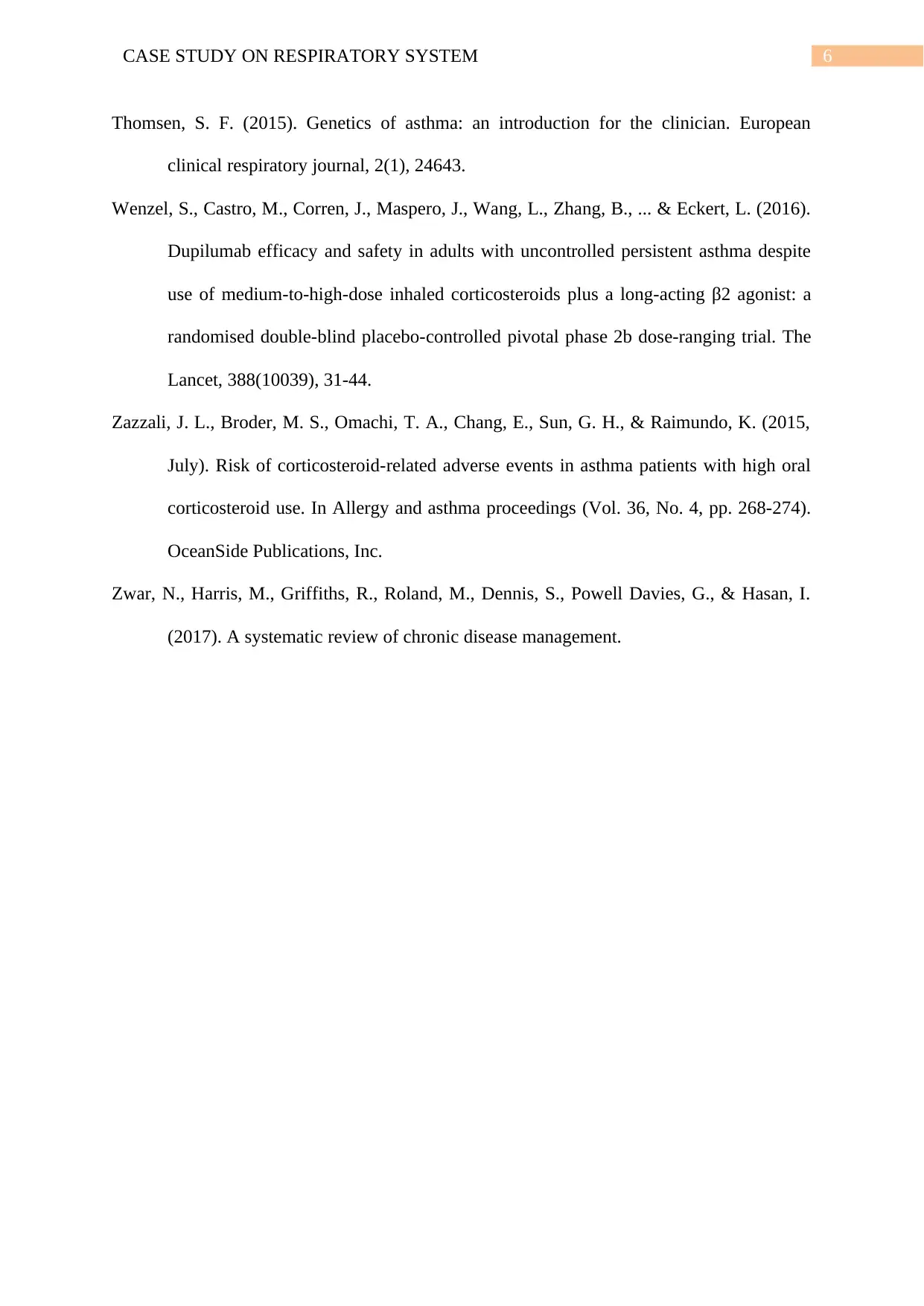
6CASE STUDY ON RESPIRATORY SYSTEM
Thomsen, S. F. (2015). Genetics of asthma: an introduction for the clinician. European
clinical respiratory journal, 2(1), 24643.
Wenzel, S., Castro, M., Corren, J., Maspero, J., Wang, L., Zhang, B., ... & Eckert, L. (2016).
Dupilumab efficacy and safety in adults with uncontrolled persistent asthma despite
use of medium-to-high-dose inhaled corticosteroids plus a long-acting β2 agonist: a
randomised double-blind placebo-controlled pivotal phase 2b dose-ranging trial. The
Lancet, 388(10039), 31-44.
Zazzali, J. L., Broder, M. S., Omachi, T. A., Chang, E., Sun, G. H., & Raimundo, K. (2015,
July). Risk of corticosteroid-related adverse events in asthma patients with high oral
corticosteroid use. In Allergy and asthma proceedings (Vol. 36, No. 4, pp. 268-274).
OceanSide Publications, Inc.
Zwar, N., Harris, M., Griffiths, R., Roland, M., Dennis, S., Powell Davies, G., & Hasan, I.
(2017). A systematic review of chronic disease management.
Thomsen, S. F. (2015). Genetics of asthma: an introduction for the clinician. European
clinical respiratory journal, 2(1), 24643.
Wenzel, S., Castro, M., Corren, J., Maspero, J., Wang, L., Zhang, B., ... & Eckert, L. (2016).
Dupilumab efficacy and safety in adults with uncontrolled persistent asthma despite
use of medium-to-high-dose inhaled corticosteroids plus a long-acting β2 agonist: a
randomised double-blind placebo-controlled pivotal phase 2b dose-ranging trial. The
Lancet, 388(10039), 31-44.
Zazzali, J. L., Broder, M. S., Omachi, T. A., Chang, E., Sun, G. H., & Raimundo, K. (2015,
July). Risk of corticosteroid-related adverse events in asthma patients with high oral
corticosteroid use. In Allergy and asthma proceedings (Vol. 36, No. 4, pp. 268-274).
OceanSide Publications, Inc.
Zwar, N., Harris, M., Griffiths, R., Roland, M., Dennis, S., Powell Davies, G., & Hasan, I.
(2017). A systematic review of chronic disease management.
1 out of 7
Related Documents
Your All-in-One AI-Powered Toolkit for Academic Success.
+13062052269
info@desklib.com
Available 24*7 on WhatsApp / Email
![[object Object]](/_next/static/media/star-bottom.7253800d.svg)
Unlock your academic potential
Copyright © 2020–2025 A2Z Services. All Rights Reserved. Developed and managed by ZUCOL.





